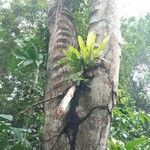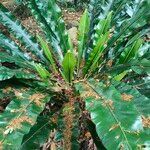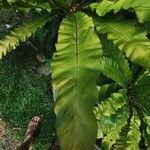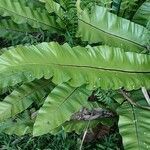Ferns with nest-like habit. Rhizome erect, scaly, unbranched with a single growing point; scales narrowly triangular, c. 1–2 cm long, with a filiform apex, cell walls dark brown. Fronds spreading horizontally before arising in a regular rosette. Stipe indistinct, 1–5 cm long, 5–8 mm wide. Rachis in cross-section prominent and often 2-angled on upper surface, flat or only slightly rounded below. Lamina narrowly obovate, simple, 90–150 cm long, 8.5–25 cm wide, shiny green and ± glabrous; bases narrowly cuneate; margins entire; apices acute; veins free except for a marginal connection. Sori very numerous, close together; longest sori 18–40 mm long, extending from midrib, usually occupying less than half width of lamina. Perispores pale with fimbriate broad ridges and fenestrate lacunae; exospores 42.9–47.8 × 28.3–32.2 µm (means).
An evergreen fern. It grows to 1.5 m high and spreads 3 m across. It can grow by feeding on other plants. It forms nest like bowls on the upper side of branches. The underground thickened horizontal stem is dark brown and short. It is covered with blackish scales. The roots are hairy. The fronds grow out from a central point so that the fern forms rounded tussocks. The fronds are simple and entire and sword shape. The fronds can be 2 m long and up to 20 cm wide. They are dark or yellowish green. They have a raised, bluntly rounded mid vein.




